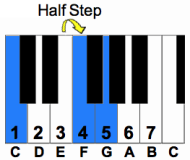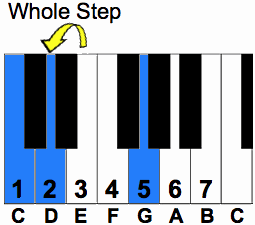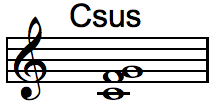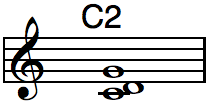Suspended chords are a very common piano chord used in todays contemporary music. They are used a lot in guitar driven songs.
It is an easy chord for a musician to add variety to a song. Rather than playing a simple major chord, a sus chord can be added for a more unexpected chord change.
Playing these chords are easy, and can make your playing style a lot more unique and can help separate you from other musicians.
What does “Sus” Mean
A lot of people think that it means sustained. The word sustain means to hold out or lengthen. Thats not what we are wanting to do with a suspended piano chord.
Actually, we are wanting to “suspend” the chord.
If you think of the definition of suspend, it means to hold up above something.
How can you hold a note above another?
Later we are going to talk about how to make a suspended chord, but the basics of a sus chord is to move the third note in the chord up one half step.
So really, when you play a sus, you are playing the note “above” the more common third note in the major chord.
This is where the name comes from. Its actually being suspended, or held above the third.
Two Types of Suspended Chords
There are two types of sus chords.
One is more commonly known as a sus, while the other is normally called a “2” chord.
In many chord books, or chord charts, you might see the 2 chord called a sus2. This can be confusing with the alternate naming. If you know both names, you should be fine.
Sus4 – The sus4 chord is the more common of the sus chords. It replaces the third note in the scale with the fourth note in the scale.
Sus2 – The sus2 is more commonly known as a 2 chords, but in some variations, is called the sus2. In this chord, you replace the third note in the scale with the second note in the scale.
How to Make Suspended Chord
The sus piano chord is built off of the major scale. In order to build it, you have to first find the major chord.
To find a major chord, you first need to know the notes in the major scale.
Let’s look at the key of C. The notes in the key of C are C, D, E, F, G, A, B. To make the major scale, you need to use the first, third, and fifth notes of that scale.

Use that chart above to help you make a major chord.
Suspended 4 Chord
To make a suspended 4 chord, just replace the third note in the scale with the the fourth note. So, in this example, you would play an F instead of the E. Making the three notes in the chord C, F, and G.
There is a little more theory behind it then just replacing the third note with the fourth note. You are actually raising the third note by a half step.
Let’s say that you don’t have a chart like we do above to show you the notes in the scale. To find the suspended chord, move the the third note in the chord up by one half step.
Take a look at the image to see what it looks like on the piano. It shows moving the third note in the scale up a half step.

Suspended 2 Chord
The suspended 2 is similar to the sus4. Here you have to replace the third note in the scale with the second note in the scale.
If you look back at the chart, you can see that you replace the E note with a D note.
The theory behind this piano chord is close to the sus4, but here you need to lower the third note by a whole step. Take a look at the image to see it in action.

Formula
The easiest way to find suspended chords is to use a number formula. We discussed this a little before, but lets look at in a little more in detail.
If you look at the two charts, you can see that the formula for the two chords is slightly different.
Sus4 Chord Formula – I – IV – V
Sus2 Chord Formula – I – II – V
 |  |
These two formulas will make it much easier for you to quickly and easily find the two suspended chords.
Sus Chords Want to Resolve
If you listen to sus chord, there is something special about them. They sound as though they need to resolve back to the third. Resolve means that it would sound more natural for the chord to fall back to another note or chord.
Its almost like the chord is incomplete unless it goes back to the third.
Take a listen to both of the C Sus chords and you will see what I mean.
Also, play the sus4 chord in one of your songs and see how it almost sounds out of place not resolving. You can take the song to unexpected places by not resolving the sus.
AUDIO
Sus on Sheet Music
The sus chord is going to look a little different then a major or minor chord on a piece of sheet music.
 |  |
Take a look at the two. As you can see they are quite different from the major chord. You can tell that the Csus is taking the middle note and moving it up, while the C2 is moving the middle note down.
Suspended chords are an easy way to add a very contemporary sound to a song. They are easy to build, and easy to play.
If you follow the I – II – V and I – IV – V formula, you’ll have no problem finding the notes in the chord.
If you get stuck without a scales chart, just remember to move the third note up a half step to make a suspended 4, and move the the third down a whole step to make a suspended 2 chord.
Need more help learning chords? Learn almost every chord you’ll ever need with our Piano Chord Encyclopedia.
Go from Suspended Chords back to Piano Chords
Back to Homepage

 william c wesley says
william c wesley says
October 18, 2019 at 7:21 pmhttps://www.youtube.com/watch?v=fA3H5yjFU3M&list=PLPYiCOgE6NBRRDktuD0VEyfzyEgTf7CSs
This instrument features octave courses where all octaves are adjacent. Any three adjacent octave courses form a suspended chord which is playable by any three adjacent fingers each of which can play all the octaves in an octaves course (15 notes in all), 2,3,4, or 3,4,5, so the suspended chord is the simplest chord to play on this system which is in the optimum arrangement for the understanding of music theory.
The keyboard is the least optimum system for the understanding of music theory.
 Cedric Short says
Cedric Short says
October 21, 2019 at 7:19 pmThis is the first time this concept has been explained to me in a way that I can clearly understand. It’s very helpful for a beginner like me.